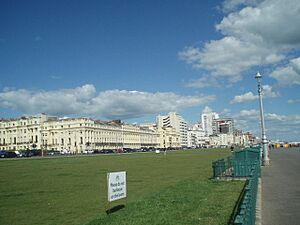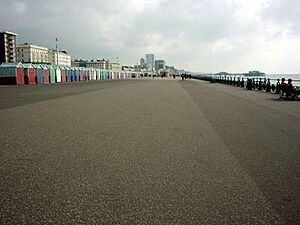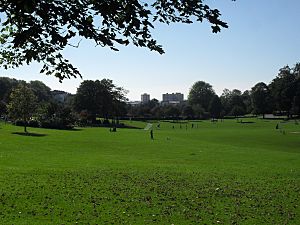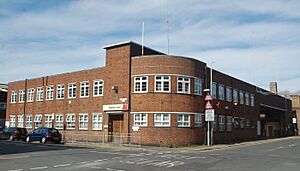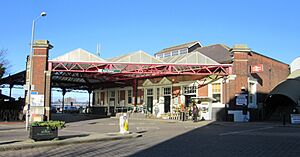Hove facts for kids
Quick facts for kids Hove
|
|
|---|---|
| City of Brighton and Hove | |
|
Beach huts, the rooftops, the Hove, Sussex County Ground and Western Road |
|
| Population | 91,900 |
| OS grid reference | TQ285055 |
| Unitary authority | |
| Ceremonial county | |
| Region | |
| Country | England |
| Sovereign state | United Kingdom |
| Post town | HOVE |
| Postcode district | BN3 |
| Dialling code | 01273 |
| Police | Sussex |
| Fire | East Sussex |
| Ambulance | South East Coast |
| EU Parliament | South East England |
| UK Parliament |
|
Hove (/hoʊv/ hohv) is a town by the sea in East Sussex, England. It is part of the larger city of Brighton and Hove, right next to Brighton.
Hove started as a small fishing village. It was surrounded by farms. In the 1800s, it grew very quickly. This happened because Brighton, its neighbor, was also growing. By the Victorian era, Hove was a full-sized town. It even had its own borough status. Over time, nearby areas like Aldrington and Hangleton joined Hove. In 1974, the town of Portslade also became part of Hove. Then, in 1997, Hove and Brighton joined together. They formed the Borough of Brighton and Hove. This area became a city in the year 2000.
Contents
What's in a Name?
The name Hove has been spelled in many ways over time. Some old spellings include Hou (from 1086) and Huve (from the 1300s). Experts have argued about where the name comes from. Some think it means "hall" or "shelter." This might refer to an old burial mound nearby.
Hove is the only place in Britain with this name. Most places in Sussex have names with more than one syllable. The name used to be pronounced "Hoove." The way we say it today, "Hohv," is quite new.
Exploring Hove's Landscape
The northern parts of Hove are built on chalk. This chalk is found all over southeast England. There are also areas with clay and sandy soil. Hove's beaches are mostly shingle (small stones). At high tide, you only see shingle. But at low tide, sand appears between the sea walls. The water is shallow, good for paddling.
Hove does not have any rivers. But some places are named after old streams. For example, Westbourne Gardens is named after the "West Bourne." This stream now flows underground.
Until the 1800s, Hove was mostly farmland. Three farms, Wick, Goldstone, and Long Barn, owned most of the land. The soil was very good for growing crops. Farmers grew oats, barley, and vegetables. Some market gardens were still there until the 1870s. Barley was grown near Eaton Road until the cricket ground was built.
Water came from wells. There was also a special spring at Wick Farm. Shepherds used this spring for their sheep. They moved sheep between Hove and the South Downs. Some shepherds also caught birds like larks to sell. This stopped when these birds became protected. Today, many old sheep paths are now roads or footpaths.
The Goldstone
A large stone called the Goldstone stood on farmland. It is now in Hove Park. Some people thought it was part of a stone circle, like Stonehenge. A farmer once buried the Goldstone. But it was dug up and put back in the park in 1906.
Hove's Green Spaces
Hove has very few old forests. Only two small areas remain. One is in St Ann's Well Gardens. The other is The Three Cornered Copse. This copse is 11 acres large. It has trees like ash, beech, and sycamore. Many beech trees were blown down in a big storm in 1987.
Most of Hove is now built up. But in 1994, about 37.5% of the area was still downland. This land was used for sheep and crops. During World War II, some land was used for military training. Toads Hole Valley is a 92-acre area. It is the "last piece of unspoiled downland in Hove." People have wanted to build on it for many years.
How Hove Grew
| Year | Area (acres) | What happened |
|---|---|---|
| Before 1800s | 778 | Original size of the parish |
| 1894 | 1,594 | Aldrington joined Hove |
| 1928 | 4,010 | More areas like Preston Rural joined |
| 1994 | 5,896 | Total area of the borough |
Hove's Weather
Hove has a mild climate. This means there are not big differences between hot and cold temperatures. It also gets enough rain all year. This type of weather is called a "Marine West Coast Climate."
| Climate data for Hove, UK | |||||||||||||
|---|---|---|---|---|---|---|---|---|---|---|---|---|---|
| Month | Jan | Feb | Mar | Apr | May | Jun | Jul | Aug | Sep | Oct | Nov | Dec | Year |
| Mean daily maximum °C (°F) | 8 (46) |
8 (46) |
10 (50) |
13 (55) |
16 (61) |
18 (64) |
20 (68) |
21 (70) |
19 (66) |
15 (59) |
11 (52) |
8 (46) |
14 (57) |
| Mean daily minimum °C (°F) | 3 (37) |
3 (37) |
5 (41) |
6 (43) |
10 (50) |
12 (54) |
14 (57) |
14 (57) |
12 (54) |
9 (48) |
6 (43) |
4 (39) |
8 (47) |
| Average precipitation days | 14 | 10 | 12 | 12 | 10 | 9 | 10 | 10 | 11 | 12 | 13 | 12 | 135 |
| Source: Weatherbase | |||||||||||||
Hove's Story: A Timeline
Ancient Discoveries
Scientists have found very old animal remains in Hove. These include an 11-pound elephant tooth and a prehistoric horse tooth.
In 1856, workers found an ancient burial mound near Palmeira Square. This mound was about 20 feet high. Inside, they found amazing treasures. One was the Hove amber cup. It's made of clear red amber and is about the size of a teacup. You can see it at the Hove Museum and Art Gallery. Only one other such cup has been found in Britain. They also found a stone axe and a bronze dagger.
Early Days (Before 1800s)
Hove was not mentioned in the Domesday Book of 1086. The first known settlement in Hove was around the 1100s. This was when St Andrew's Church was built. For centuries, Hove stayed small. It was just one street. By the 1500s, the church was in ruins.
Hangleton Manor is a well-preserved building from the 1500s. It was built around 1540. Today, it is a pub-restaurant. It used to be in open countryside. Now, it is surrounded by houses.
In 1723, a traveler wrote that Hove was a "ruinous village." He thought the sea was "eating up" the coast. But around 1702, The Ship Inn was built by the sea.
In 1724, Daniel Defoe wrote about smuggling along the south coast. Hove was known for this illegal trade. Smugglers often hid their goods in St. Andrew's Church. The Ship Inn was a popular meeting spot for them. In 1818, there was a big fight on Hove beach between smugglers and tax officers. The smugglers won. To stop smuggling, a coastguard station opened in 1831.
Growing Pains (1800s)
In 1801, Hove had only 101 people. Brighton had 7,339. By 1821, Hove's population grew to 312. Brighton's population tripled. Hove was still mostly farms.
In the 1820s, the Brunswick estate was built. These were large, fancy houses by the sea. They had a theater and riding schools. Even though they were in Hove, people living there used "Brighton" as their address. This was because Hove was seen as a poor village.
The Brighton to Shoreham turnpike road was built in 1822. It followed the route of today's Old Shoreham Road.
The Brighton and Hove Gas Company started in 1825. They built a gasworks near St Andrew's Church in 1832. Brunswick Terrace houses were the first to get gas lights. The gas production moved in 1871. A very large gas holder was built in Hove in 1877. It was used until 1994.
By 1831, Hove's population grew to 1,360. But the old village of Hove did not benefit much. One historian called it "a mean and insignificant assemblage of huts."
St Andrew's Church was rebuilt in 1836. It was designed in a Neo-Gothic style.
From 1848 to 1871, Sussex County Cricket Club played in Hove. In 1872, they moved to the current ground.
More large housing areas were built. These included Cliftonville and West Brighton Estate. They also avoided using the name Hove. The West Brighton Estate has many beautiful Victorian houses. These include the numbered avenues like First Avenue.
Hove has wide, grand streets. Many old mansions are now flats. Marlborough Court was once home to the Duchess of Marlborough. The Irish politician Charles Stewart Parnell visited Hove. He died there in 1891.
The Hove Club, a private club, was founded in 1882.
The 1900s
In the 1910s, eleven cottages were built on the beach. They were called Seaside Villas. Many famous people have lived there. These include the poet Robert Graves and the playwright Joe Orton. More recently, celebrities like Adele and David Walliams have lived there. DJ Fatboy Slim owns a nearby cafe.
In 1966, Hove Town Hall burned down. It was replaced by a new building.
World War I
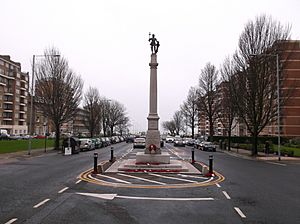
Over 600 men from Hove died in the First World War. After the war, a committee decided to build a memorial. They asked Sir Edwin Lutyens to design it. He designed the Cenotaph in London. Lutyens suggested a similar design for Hove. But the committee did not like it. They chose a statue of Saint George on a column instead. It is in the middle of Grand Avenue. The names of the fallen are on a bronze plaque in Hove Library.
World War II
At the start of World War II, Hove Marina was used as a training base. It trained new officers for the Royal Navy. It was called HMS King Alfred. By the end of the war, it had trained over 22,500 officers.
In September 1939, an important meeting was held at Hove Town Hall. Leaders from Britain and France met to discuss the war. The British Prime Minister, Neville Chamberlain, was there. The French Prime Minister, Édouard Daladier, was also present.
The Brighton and Hove area was bombed heavily by German planes. This was called the "Brighton Blitz." It caused the deaths of 198 civilians.
Shopping in Hove
Hove's town center was updated in the late 1990s. George Street became a pedestrian-only area. Some people worried this would hurt businesses. But these worries were wrong. In 2003, a large supermarket (Tesco) opened there. It was built where an old gasometer used to be.
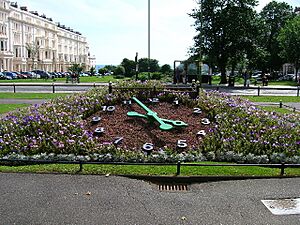
Places to Visit
Churches and Other Worship Places
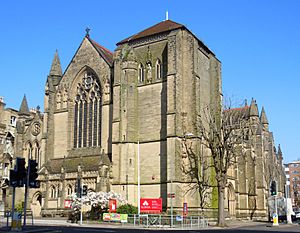
Hove has many churches and places of worship. St Andrew's Church was the oldest church. It was rebuilt in the 1830s. Other old churches include St Helen's and St Peter's.
Many new churches were built as Hove grew. These include St John the Baptist's (1852) and All Saints (1889). All Saints Church is a very important building. Some churches have closed over the years.
The Church of the Sacred Heart was Hove's first Roman Catholic church. It opened in 1887. Later, other Catholic churches were built, like St Peter's (1915).
Methodists, Baptists, and other Christian groups also have churches in Hove. The Central United Reformed Church was built in 1870.
The Salvation Army has been in Hove since 1882. Jehovah's Witnesses and other groups also have places of worship. The former Anglican church on Davigdor Road is now St Mary and St Abraam Church. It serves Coptic Orthodox Christians. Buddhists also have a center in Hove.
Hove Museum of Creativity
Hove Museum of Creativity is a museum owned by the city. It has a collection of toys, crafts, art, and local history items. It also hosts new art shows.
Learning in Hove
Hove has many primary schools. These include West Blatchington Primary and Goldstone Primary. There are four secondary schools: Blatchington Mill, Cardinal Newman, Hove Park School, and King's School.
Brighton Hove & Sussex Sixth Form College (BHASVIC) is a place for further education. Hove also has private colleges like Hove College. There are several private schools too.
Sports and Fun
Sussex County Cricket Club plays at the County Cricket Ground, Hove. This ground hosts county, national, and international matches. It is also used for music concerts.
Until 1997, the Brighton & Hove Albion F.C. football club played at the Goldstone Ground in Hove. The club is called The Seagulls. In 2011, they moved to a new stadium in Falmer.
Brighton & Hove Hockey Club also has its home ground in Hove.
Hove has several parks. These include Hove Park and St. Anne's Well Gardens. The gardens have many different trees and a scented garden. The King Alfred Centre is a leisure center with a swimming pool. There were plans for a big new development there, but it was canceled.
Hove Promenade parkrun is a free 5km run held by Hove Lawns. Hove Lawns are large grassy areas along the seafront.
The Monarch's Way is a long walking path. It goes through Hove and along the seafront.
"Hove, actually"
People from Hove sometimes say "Hove, actually" when asked if they live in Brighton. This is a funny way to show that Hove is different from Brighton. Some say the actor Laurence Olivier started this phrase. In the 1990s, Hove's council used "Hove, actually" to attract tourists.
Getting Around Hove
Hove has several main roads. The A259 runs along the seafront. The A270 Old Shoreham Road is another main road. The A2023 goes north through central Hove. Other important roads include Grand Avenue and Church Road.
In 1906, Hove had about 34 miles of roads. By 1948, this grew to 74 miles. Some roads were still paved with wood back then.
Buses
Many bus routes serve Hove. Most are run by Brighton & Hove. You can take buses to many parts of the city and beyond.
Hove's first bus service started in 1853. It went from the Ship Inn to Black Rock. At first, buses were pulled by horses. Then, petrol and electric buses were used. Thomas Tilling became a major bus operator in Hove. His company later became the Brighton, Hove and District Omnibus Company. Today, the Brighton & Hove Bus and Coach Company is the main operator.
Trains
The first train station called Hove opened in 1840. It closed in 1880. A new station, Holland Road Halt, opened nearby in 1905. It closed in 1956.
The current Hove railway station opened in 1865. It was called Cliftonville at first. It changed names several times before becoming Hove in 1895. Further west, Aldrington railway station opened in 1905. Portslade railway station opened in 1840. All three stations are managed by Southern.
There was once a train line from Aldrington station to Devil's Dyke. It opened in 1887 and closed in 1938.
There are also two train tunnels near Hove. One is 535 yards long. The other is 220 yards long.
Taxis
The first taxi licenses in Hove were given out in 1859. People could choose from many types of carriages. The first motor taxi was licensed in 1908. But horse-drawn carriages were still used until after 1925. Today, taxis are white and aqua. The city council sets the fares. Hove has 17 taxi stands.
Famous People from Hove
- Jonathan Bailey (born 1988), actor.
- Carl Cox, a famous DJ.
- Sir Jack Hobbs (1882–1963), a famous cricketer.
- Richard Jefferies (1848–1887), a nature writer. He lived in Hove and wrote a book there.
- Charles Stewart Parnell (1846–1891), an Irish politician. He lived in Hove and died there.
- Margaret Powell, writer (1907–1984), was born in Hove. A bus is named after her.
- Bernard Youens (1914–1984), actor, known for Coronation Street.
See also
 In Spanish: Hove para niños
In Spanish: Hove para niños








